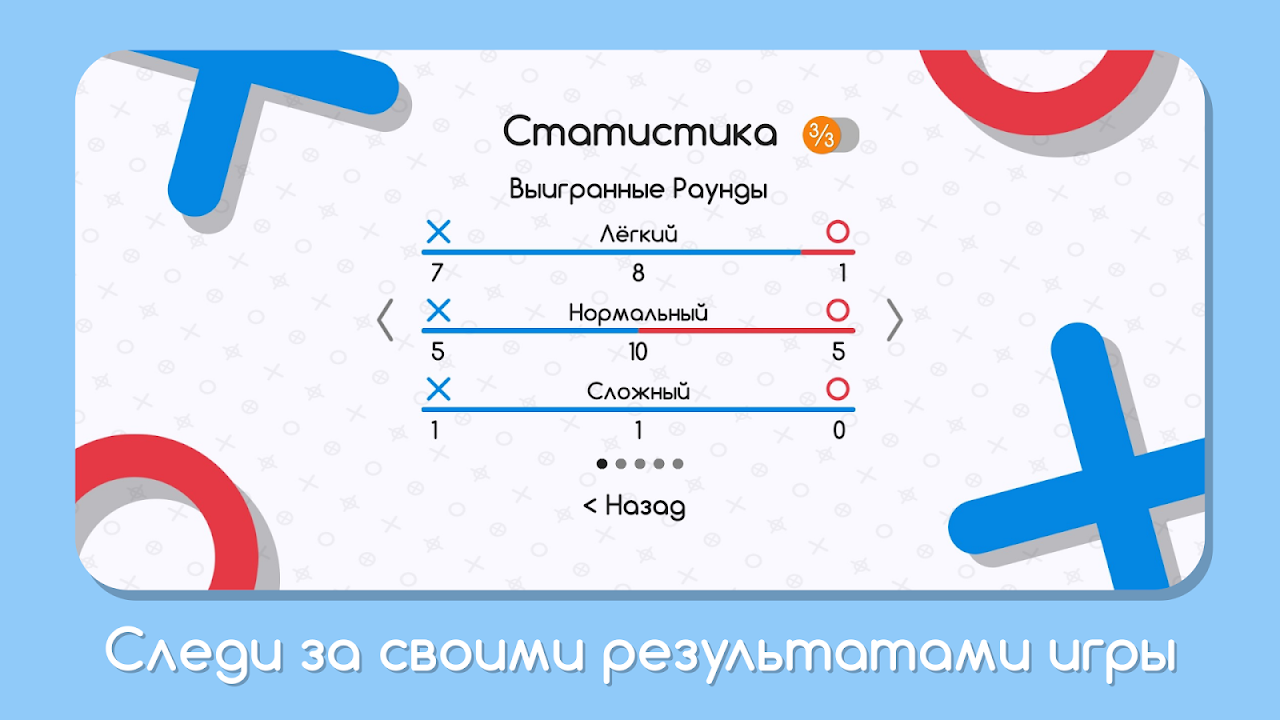“Double Tic-Tac-Toe” is a complicated version of the classic Tic-Tac-Toe, with the only difference being that you can cover your opponent’s squares with your sign. The use of “overlap” increases tactical possibilities and gives new sensations from the game.
Двойные Крестики-Нолики, translating to Double Tic-Tac-Toe in English, is a complex and engaging strategy game that expands upon the classic Tic-Tac-Toe. It elevates the simple gameplay of its predecessor by introducing a multi-layered board and intricate win conditions, requiring players to think several steps ahead and anticipate their opponent's moves with greater depth. The game is played on a 3x3 grid of smaller 3x3 grids, essentially a Tic-Tac-Toe board within a Tic-Tac-Toe board. This nested structure creates a dynamic interplay between local and global strategies, where winning individual smaller boards contributes to winning the overall game.
The game begins with the first player, typically designated as 'X', placing their mark in any empty cell within any of the nine smaller grids. This initial move dictates where the second player, 'O', must place their mark. The chosen cell in the first turn corresponds to the smaller grid where 'O' must play. For example, if 'X' plays in the top-right cell of the center grid, then 'O' is forced to play within the top-right grid. This forced placement continues throughout the game, creating a chain reaction of moves and restricting player choices. If a player is sent to a smaller grid that is already full or won, they then have the freedom to place their mark in any available cell on any other grid.
Winning a smaller grid follows the traditional Tic-Tac-Toe rules: achieve three marks in a row, column, or diagonal. Once a smaller grid is won, it is typically marked with the winning player's symbol, signifying their control over that area. The overall game is won by achieving three won smaller grids in a row, column, or diagonal on the larger 3x3 grid. This introduces a strategic layer beyond simply winning individual smaller grids. Players must not only focus on immediate victories within the smaller grids but also plan their moves to secure strategically important grids that contribute to their overall victory on the larger board.
The complexity of Double Tic-Tac-Toe arises from the interplay between these local and global objectives. A player might sacrifice a smaller grid to force their opponent into a position that benefits their overall strategy. The forced placement rule adds another layer of complexity, as players can manipulate their opponent's moves by strategically choosing their placement. This can lead to situations where a player is forced to play in a grid that benefits their opponent, creating difficult choices and strategic sacrifices.
The game requires a higher level of foresight and planning compared to traditional Tic-Tac-Toe. Players must consider not only their immediate moves but also the potential consequences several turns ahead. Anticipating the opponent's responses and planning counter-strategies are crucial for success. The game's depth prevents simple memorization of winning patterns and encourages dynamic, adaptive gameplay.
Double Tic-Tac-Toe is a challenging and rewarding game that offers a significant strategic depth. It's a game that rewards careful planning, tactical thinking, and the ability to adapt to changing game states. The added complexity makes it a more engaging and less predictable experience than its simpler counterpart, providing a stimulating mental exercise for players of all skill levels. The game encourages players to think strategically, anticipate their opponent's moves, and develop a deeper understanding of positional play. It's a game that can be enjoyed by casual players looking for a more challenging puzzle and by serious strategists seeking a complex and rewarding game experience.
The game’s intricate ruleset allows for a wide variety of strategic approaches. Offensive players can focus on quickly securing smaller grids and building towards an early victory. Defensive players can prioritize blocking their opponent’s progress and forcing them into unfavorable positions. A balanced approach often proves most effective, combining offensive maneuvers with defensive strategies to control the flow of the game. The ability to adapt one’s strategy based on the opponent’s moves and the current game state is a key skill for success in Double Tic-Tac-Toe. This dynamic nature ensures that each game is unique and presents new challenges, preventing the gameplay from becoming stale or repetitive.
While the game shares its name and some basic mechanics with Tic-Tac-Toe, it offers a vastly different gameplay experience. The layered board structure and the forced placement rule introduce a level of complexity that transforms the simple game of Tic-Tac-Toe into a strategic battle of wits. Double Tic-Tac-Toe is a testament to how a simple concept can be expanded upon to create a much deeper and more engaging game. It’s a game that rewards strategic thinking, foresight, and adaptability, providing a challenging and rewarding experience for players of all levels.
“Double Tic-Tac-Toe” is a complicated version of the classic Tic-Tac-Toe, with the only difference being that you can cover your opponent’s squares with your sign. The use of “overlap” increases tactical possibilities and gives new sensations from the game.
Двойные Крестики-Нолики, translating to Double Tic-Tac-Toe in English, is a complex and engaging strategy game that expands upon the classic Tic-Tac-Toe. It elevates the simple gameplay of its predecessor by introducing a multi-layered board and intricate win conditions, requiring players to think several steps ahead and anticipate their opponent's moves with greater depth. The game is played on a 3x3 grid of smaller 3x3 grids, essentially a Tic-Tac-Toe board within a Tic-Tac-Toe board. This nested structure creates a dynamic interplay between local and global strategies, where winning individual smaller boards contributes to winning the overall game.
The game begins with the first player, typically designated as 'X', placing their mark in any empty cell within any of the nine smaller grids. This initial move dictates where the second player, 'O', must place their mark. The chosen cell in the first turn corresponds to the smaller grid where 'O' must play. For example, if 'X' plays in the top-right cell of the center grid, then 'O' is forced to play within the top-right grid. This forced placement continues throughout the game, creating a chain reaction of moves and restricting player choices. If a player is sent to a smaller grid that is already full or won, they then have the freedom to place their mark in any available cell on any other grid.
Winning a smaller grid follows the traditional Tic-Tac-Toe rules: achieve three marks in a row, column, or diagonal. Once a smaller grid is won, it is typically marked with the winning player's symbol, signifying their control over that area. The overall game is won by achieving three won smaller grids in a row, column, or diagonal on the larger 3x3 grid. This introduces a strategic layer beyond simply winning individual smaller grids. Players must not only focus on immediate victories within the smaller grids but also plan their moves to secure strategically important grids that contribute to their overall victory on the larger board.
The complexity of Double Tic-Tac-Toe arises from the interplay between these local and global objectives. A player might sacrifice a smaller grid to force their opponent into a position that benefits their overall strategy. The forced placement rule adds another layer of complexity, as players can manipulate their opponent's moves by strategically choosing their placement. This can lead to situations where a player is forced to play in a grid that benefits their opponent, creating difficult choices and strategic sacrifices.
The game requires a higher level of foresight and planning compared to traditional Tic-Tac-Toe. Players must consider not only their immediate moves but also the potential consequences several turns ahead. Anticipating the opponent's responses and planning counter-strategies are crucial for success. The game's depth prevents simple memorization of winning patterns and encourages dynamic, adaptive gameplay.
Double Tic-Tac-Toe is a challenging and rewarding game that offers a significant strategic depth. It's a game that rewards careful planning, tactical thinking, and the ability to adapt to changing game states. The added complexity makes it a more engaging and less predictable experience than its simpler counterpart, providing a stimulating mental exercise for players of all skill levels. The game encourages players to think strategically, anticipate their opponent's moves, and develop a deeper understanding of positional play. It's a game that can be enjoyed by casual players looking for a more challenging puzzle and by serious strategists seeking a complex and rewarding game experience.
The game’s intricate ruleset allows for a wide variety of strategic approaches. Offensive players can focus on quickly securing smaller grids and building towards an early victory. Defensive players can prioritize blocking their opponent’s progress and forcing them into unfavorable positions. A balanced approach often proves most effective, combining offensive maneuvers with defensive strategies to control the flow of the game. The ability to adapt one’s strategy based on the opponent’s moves and the current game state is a key skill for success in Double Tic-Tac-Toe. This dynamic nature ensures that each game is unique and presents new challenges, preventing the gameplay from becoming stale or repetitive.
While the game shares its name and some basic mechanics with Tic-Tac-Toe, it offers a vastly different gameplay experience. The layered board structure and the forced placement rule introduce a level of complexity that transforms the simple game of Tic-Tac-Toe into a strategic battle of wits. Double Tic-Tac-Toe is a testament to how a simple concept can be expanded upon to create a much deeper and more engaging game. It’s a game that rewards strategic thinking, foresight, and adaptability, providing a challenging and rewarding experience for players of all levels.









